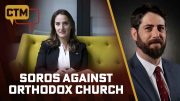
Over 200 people gathered to sing hymns and listen to some of the leaders of the protest, later breaking into small groups to kneel and pray in front of barricades at the school. After warning the protesters to leave, police made the arrests for disorderly conduct.
As reported by Baptist Press News, the city’s board of education had earlier “banned religious use of schools on Sunday mornings or at other times the schools are otherwise unused — even though the churches rent the space, dropping an estimated several million dollars per year into the city cashbox.” The ban will displace over 150 congregations that had used use school spaces, and with a scarcity of other available locales, many of the churches are in danger of folding if the city does not reconsider the policy.
A week before the latest incident, police had arrested New York City Councilman and pastor Fernando Cabrera and six others after they protested the ban — along with the New York City Housing Authority’s (NYCHA) decision to review its leases with churches renting space at community centers — by kneeling, praying, and singing hymns outside the doors of the New York City Law Department.
While the NYCHA has promised that it does not intend to ban churches from its jurisdictions, the school board said it would stick with its decision to disallow churches from meeting at schools as of mid-January.
The New York Times reported that on January 9, as time appeared to be running out on the congregations, some 200 individuals gathered at Calvary Baptist Church on West 57th Street “to pray for God to soften Mayor Michael R. Bloomberg’s heart.” Among that number were some of the individuals who were later arrested at the Mayor’s speech.
The Rev. Dimas Salaberrios, pastor of Infinity New York Church, said that he and other area church leaders were fasting and praying for a reversal by the city. “If the body of Christ hurts, then let my body suffer along with it,” he said. “We are hoping that someone will research a little further to see that the churches have been doing good works, and that it will be self-destructive to the city to kick them out.”
The situation came to a head late last year when the Bronx Household of Faith, one of the churches meeting in a school, lost its final appeal in a 16-year fight with the city over using the public space. “A federal appeals court had ruled that a state education law permitting school districts to ban the worship services was legal,” reported the Times, “and in December, the Supreme Court declined to hear the case.”
The Times noted that around the nation school buildings are often used by churches that are just starting up, or that have no other place to meet, “and in 2001 the Supreme Court ruled that religious organizations must have equal access to public school space for activities like club meetings and religious lessons.” But the recent decision by the appeals court “permitted the banning of worship services from schools, because, in part, they could imply government endorsement of a particular faith.”
While Sheila Stainback, a NYCHA spokeswoman, insisted that churches meeting in community centers were in no danger of losing their space, and Jane Gordon, senior counsel at the Law Department, said that there was “absolutely no connection” between the school board’s actions and the Housing Authority’s agreements with churches, the affected congregations are still concerned that Mayor Bloomberg is angling for a total ban of churches from city property.
Jordan Lorence of the Alliance Defense Fund, the legal advocacy group assisting NYC churches that are being displaced, said the city appeared to be using the ruling against the Bronx Household of Faith as justification to ban congregations from other public buildings, particularly in the case of the NYCHA, which had informed several churches meeting in community centers that their short-term leases were no longer valid. “They can’t use the Bronx Household case as some kind of all-purpose permission slip to banish private worship services from every public venue,” Lorence said of the city’s efforts.
“Churches and other religious groups should be able to meet in public buildings on the same terms as other community groups,” argued Lorence. “These churches offer the people in hurting communities hope and help for their daily needs. To drive out the churches based on a discredited, extreme notion of ‘separation of church and state’ benefits no one and harms people who need help most.”
Lorence told the Christian Post he is concerned that New York City’s efforts to restrict the use of public facilities by churches might spread to other parts of the country. “I think that it will inspire some people to restrict churches,” he said. “It gives validity to … this false and wrong understanding of the establishment clause, that the government is under some sort of duty to go on a search-and-destroy mission for private … forms of religion, including private religious expression, and expunge it from the public square.”
Tony Perkins of the Family Research Council warned that such a move would jeopardize “a longstanding cooperation between cities and faith-based groups. “If you trace the roots of some of America’s largest churches … most of them started in rented schoolrooms. Now, it seems a struggling [school] system like New York City’s would rather turn away income than allow for the free exercise of religion.”
Perkins noted that New York City’s Department of Education “has long given congregations the option to hold their weekend services in any one of the city’s empty school buildings provided, of course, they pay to use the facilities — a nice benefit to the cash-strapped public education system. By disallowing some groups over others because … they are religious, Mayor Bloomberg has engaged in nothing other than viewpoint discrimination.”
According to BP News, some government leaders are trying to find a way around the city’s ban. Among them are New York Assemblyman Nelson Castro, who introduced a bill into the state legislature that would allow for “the use of school buildings and school sites for religious meetings and worship when not in use for school purposes or when such service or worship is deemed not disruptive of normal school operations.”
Photo of Michael Bloomberg: AP Images




